Shelf Life
Metal Mania
by Erin Finnegan,

None
Rental Shelf
Super Gals Complete Collection DVD
Detroit Metal City live action DVD
Hayate the Combat Butler Part 4 DVD
Perishable
None
I thought I was a better student than Ran Kotobuki!
 I fricking love subcultures, and I like shojo a lot, so I was happy to shell out money for Super GALS! back in the day (2005ish). I even preordered season two and got my name on the DVD credits. But when season two finally arrived at my door in 2007, I never finished watching it. I ran out of steam, or maybe after the long delay between releases, the show became irrelevant.
I fricking love subcultures, and I like shojo a lot, so I was happy to shell out money for Super GALS! back in the day (2005ish). I even preordered season two and got my name on the DVD credits. But when season two finally arrived at my door in 2007, I never finished watching it. I ran out of steam, or maybe after the long delay between releases, the show became irrelevant. After all, nothing changes faster than trends among high school girls in the Shibuya neighborhood of Tokyo, and that's exactly what this show is about. Unfortunately, due to the rapid fashion turnover, Gals seems severely dated (it's not old enough to be cool and retro like Dirty Pair). As far as I can tell, the extreme teen girl subculture today is hime gals.
Super GALS! is quick to distance itself from the most extreme of kogals, the infamous super-tan ganguro girls. “I'm a pale-faced gal,” protagonist Ran Kotobuki explains in episode one. Kogals were also infamous for pay dates, but Ran intervenes when her new friend Aya is about to stoop to compensated dating.
The first time I watched Gals, it never struck me how whitewashed it is. Ran comes from a family of police officers, and even her kid sister wants to be a detective. Despite Ran's proclamations that she's a “gal to the end” and will never be a cop, she ends up acting as a hero of justice in Shibuya. Ran stops shoplifters by throwing her platform boots at the criminals. She may not realize it, but Ran's hanging out is often closer to patrolling like a beat cop. I wonder if this was an attempt by Ribbon to make a crime-associated subculture seem safe for kids.
The animation is bright and colorful, and slightly ADD. There are excessive cutaways to eyecatches. Chibi figures pop in to teach you gal slang periodically, further breaking up the action. Some of the eyecatch antics are para-para chibi dance breaks, which adds up to a dizzying, sugar-high viewing experience.
Re-watching Gals, I found Ran's moral compass or lack thereof alarming. Ran is incredibly petty. Her callousness towards her boyfriend in the show is particularly troubling. Her monkey-like “showboat boyfriend” TATSUKI cares for Ran far more than she cares for him. Ran is cruel to poor TATSUKI, dodging his kisses and even stooping to dating his younger brother for a free meal in one episode. The question of Ran's love for TATSUKI is left hanging right through to the end.
The second season introduces a few anime-only characters, including a young girl with even fewer morals than Ran to act as a foil, and a Shibuya café owner who provides a hang-out spot and waitress jobs for some of the girls. Taking the show indoors is the anime equivalent of the season of The Facts of Life that was set in a candy store (not that anyone remembers it); in other words, it's a bad idea to take anime about street culture off the street. That said, the Shibuya backgrounds in season two are much more photo-realistic.
The first season is dubbed, but not the second. The dub doesn't hold up well compared to today's more sophisticated performances. All of the gals sound a little too old for their age. The screen writers have done their best to adapt the gal slang, which is explained in extensive translation note extras. Sometimes the slang works in English, sometimes it doesn't. “Don't get carried!” ("don't get carried away") sounds awkward every time.
Nevertheless, if you like the hyperactivity of Kodocha and/or the Shibuya street culture in The World Ends with You you should buy Super GALS!.[TOP]
Super GALS! took a long time to re-visit, so I needed to squeeze in something short this weekend and decided to check out Detroit Metal City.
 I love the DMC manga, although I had to stop reading it on the subway after the scatological theme band appeared in volume three (happily they are absent from this film). I also love the DMC anime (when can I buy that?).
I love the DMC manga, although I had to stop reading it on the subway after the scatological theme band appeared in volume three (happily they are absent from this film). I also love the DMC anime (when can I buy that?).I heard from a very reliable big-time DMC fan that this movie was terrible, so my expectations were really, really low. I was pleasantly surprised that I was able to enjoy this film, even if it wasn't very good. As far as low budget rock and roll movies go, this is a lot better than the Guitar Wolf zombie film Wild Zero or the made-for-TV abomination KISS Meets the Phantom of the Park. (Gene Simmons is in this film too, but without the make-up I didn't recognize him.)
Detroit Metal City, if you haven't heard of it, is about Soichi Negishi, a would-be Swedish-pop singer who lands a job in a metal band straight out of college. Negishi still sings his pop ballads on street corners in his free time, but by night he is Krauser, a fictional demon lord from hell and lead singer in a death metal band with a cult following. The film follows DMC's rise to fame and Negishi's attempt to date his college crush, Aikawa, who knows nothing about his double life.
The film does a great job of portraying Soichi's “trendy” ideal lifestyle of going to fashionable cafes with modern furniture. It fails at capturing the metal side of the story. In the manga, DMC's label's office looks like a crappy low-rent room with stained walls. In the film, the office looks like Queen Bansheera's lair from Power Rangers. Clearly the production staff should have watched Metalocalypse to get an idea of the true spirit of metal set design.
For the most part, the film is loyal to the manga. The plot is basically the same, covering Soichi's amusement park incident and his visit to his parent's house. (Soichi's mother, Yoshiko Miyazaki, delivers the best performance in the film.) The differences seem jarring, as in the case of the label president's office – and shouldn't Nina be American (and blonde)? I sorely felt the absence of the Capitalist Pig as a character (he's a middle aged man in underwear who gets abused on stage).
The film throws in the theme; “No music, no dreams,” which seems lame and tacked on. Coupled with Ken'ichi Matsuyama's over-the-top, whiney performance as Soichi, the film sorely misses the point of DMC. The story hinges on the fact that Soichi has a natural talent for being Krauser. He's the best possible Krauser.
The music in the film is alright. DMC sounds more like post-"Black Album" Metallica than death metal. The Kintama' Girls, a punk all girl band that hates DMC, makes a brief appearance, but as in the NANA films, the music they're singing is clearly pop and not punk. Since nothing is more fun than arguing about music genres in a forum, that's all I have to say on this topic.
I've been disappointed by Japanese cinematography lately. 20th Century Boys and even critically acclaimed films like Always were clearly shot by television camera crews. Not that there's anything wrong with television, but if I shelled out $25 for a movie ticket in Japan (or $13 in New York), I expect to see a movie, not a made-for-TV feature of the week. The DMC film suffers from TV set-ups and some questionable TV lighting. The band appears to play the same venue over and over again, probably to save money in the film's budget. The venue is not nearly beat up enough inside.
You're probably better off consuming DMC in any other form of media, but like I said, you could do a whole lot worse.[TOP]
I rounded out the week with another Rental Shelf comedy.
 I saw the first episode or two of Hayate the Combat Butler and read the first volume of the manga, then I skipped ahead to this set of Hayate because it came out in 2010, in part because my friends the Reverse Thieves endlessly recommend this title, and I trust them… to an extent.
I saw the first episode or two of Hayate the Combat Butler and read the first volume of the manga, then I skipped ahead to this set of Hayate because it came out in 2010, in part because my friends the Reverse Thieves endlessly recommend this title, and I trust them… to an extent.Hayate is truly meta-anime. It is anime comedy for the advanced anime enthusiast. The show's better jokes don't stand on their own very well but hinge on the viewer's prerequisite knowledge of anime and manga series going back several decades. I am simultaneously impressed, depressed, and disgusted with myself when I get the jokes because oh my god I have watched so much anime. When I laugh, I'm never sure if I should feel proud or if I've wasted my life.
In case you've never seen it, title character Hayate is a poor boy whose irresponsible parents sold his body (organs and all) to the yakuza to pay off their gambling debts. Hayate is bought out of yakuza debtor hell by a rich girl, Nagi, and hired to work as her butler. Nagi is a manga/anime/games otaku. The plot unfolds with an elastic reality; thanks to Nagi's Richie Rich style fortune anything can happen. Hayate's status as a butler and Nagi's relatively young age (13) seem necessary to parody contemporary anime, so much of which contains maids and elite all-girl schools. Nagi has a crush on Hayate, leading to many shojo or erocom style misunderstandings. The “Combat” in the title refers to Hayate's infinite capacity to take a beating in a wide variety of situations as the plot calls for it.
This set won me over by starting with a parody of Fishing Enthusiast Sanpei (Fred Schodt translates Tsurikichi Sanpei as Fishing Crazy Sanpei). Nagi reads a similarity titled manga and insists on going fishing. Her estate happens to be so large that it has a lake, so Nagi and Hayate go fishing with Maria, Nagi's maid. Sanpei is a 37 year old best-selling manga classic, but I don't think most Americans would know of it (unless they've attended my “Unusual Manga Genres” panel). This episode demonstrates the malleability of the show quite well; basically anything can happen on Nagi's property.
My test for comedies is whether or not they make me laugh out loud, and how often. Hayate seems to have one good laugh-out-loud moment per episode. The humor isn't as accessible as something like Azumanga Daioh, and it's not quite as funny as later episodes of Lucky Star, although it is on the same otaku humor level as the latter. It doesn't make me laugh as much as Gintama, but it is much funnier than My Bride is a Mermaid.
There is no dub, but many of the Japanese vocal performances are noteworthy. The narrator, Norio Wakamoto (Onsokumaru from Ninja Nonsense), has a bizarre and funny way of saying things (could he be my new favorite seiyuu?). Nagi's illegitimate half-brother, Gilbert (Tooru Nara) has a ridiculously bad American accent when he speaks Japanese (I suspect that's how I sound when I speak Japanese). The talking pet tiger, Tama, has a hilarious voice (Juurouta Kosugi) as well.
I don't care for the character designs in this show. They look alike, with very flat hair and big heads and matchstick thin bodies (more so than most anime characters). I have a hard time distinguishing between the supporting characters at Nagi's school, although that could also be because I missed all the character introduction episodes.
There aren't any extras and all the episodes come on a single disc. However, unlike Glass Mask and some other Sentai Filmworks releases, at least the disc has scene selection. It's hard to remember which episode you left off on without it.
I don't think I would buy Hayate unless I was a completist, and possibly a home owner, perhaps with a very large attic library of anime. I don't think it's terribly re-watchable.[TOP]
Now I'm off to see how much anime I can watch and kanji I can learn over Thanksgiving. Do you think it's appropriate if I take these Fist of the North Star DVDs to my friend's Thanksgiving party? I hope so! I mean, what were they planning to watch? Football?

This week's shelves are from David Doub:
"My Name is David Doub and I'm the Publisher for Dusk Comics. I've been reading and collecting comics since I was 12 years old when I discovered comics in the spinner rack at the 7-11 in Hillsborough Ft.
The bulk of my collection are in long boxes currently in storage because of a moving homes. I honestly don't know how many single issue comics I have. But all that is out at this point are Graphic Novels, Manga, Anime DVD/VHS.
In the first 3 pictures you can see my one bookcase that mainly has manga from a bunch of Clamp ones to some in raw Japanese. Also the bottom shelf is my whole collection of Heavy Metal Magazine from the 1990s to current.
The next 4 pictures are of my anime VHS tapes. I've actually had to buy extra new VHS players for fear they won't be around any more. Also some of the Anime is currently out of print so the only form you get them in is VHS. Also when DVDs hit big, VHS became dirt cheap and I'm all about the cheap. I actually had to get rid of a bunch of duplicates because I was buying so many tapes in bulk I'd get a lot of dupes. I think some old fan sub copies are still in this bookcase.
The next 3 pictures are my anime DVDs and boxsets. Mixed in with the anime DVDs, is most of the current DC Superhero DVDs and some big VHS box sets of Xena (I still love that show).
And the last 4 pictures are my Graphic Novels, More Manga and various Japanese Novels. I was enjoying Light Novels like Slayers the Faust Collection from Del Ray, but I'm currently hooked on any book by the Viz Label Haikasoru. By the way, Battle Royale is a much better book than it is a manga. Also since most of my American comics are single issues, I still haven't made a big switch into Graphic Novels. Basically I got collections of series that were hard to collect now days. There is some themes in there, like I totally got hooked on the Dark Horse Omnibuses. And I must give a shout out to Adam Warren and his GN Series – Empowered.
And to complete the Nerdism of it all, the bottom of these shelves has RPG books. Mostly showing are Warhammer Fantasy and 40k.
And yes I took a copy of the British edition of my own comic, Dusk, so there is a hidden plug.
You can Buy Dusk Vol 1 and 2 at -
http://www.amazon.com/Dusk-Vol-2-David-Doub/dp/0982920512"




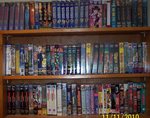
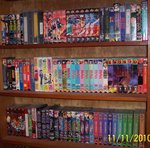
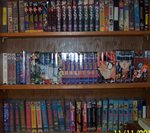

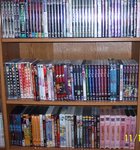


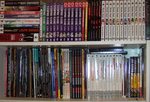

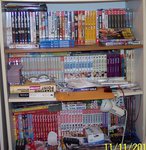
Thanks for sharing your shelves!
Want to show off your stuff? Send your jpgs to shelflife at animenewsnetwork dot com!
discuss this in the forum (19 posts) |